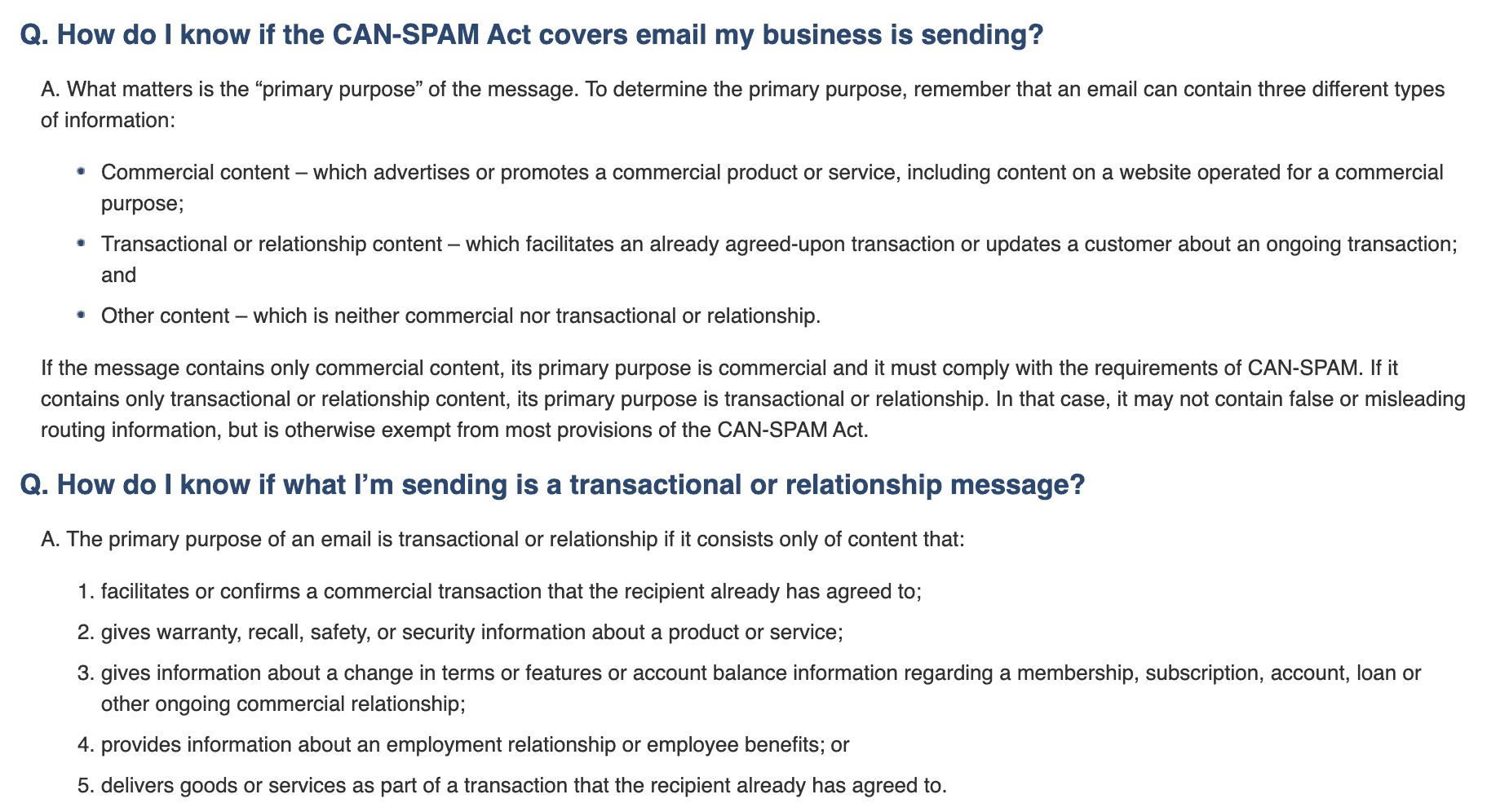Every business owner who uses email and text marketing should have a fundamental understanding of what the CAN-SPAM Act is and does. This act is a law that governs how commercial messages can be used, and if violated there are some strict penalties.
As a note, this article is for informational purposes only. It is not intended as legal advice or a comprehensive summary of the law. You are encouraged to retain your own legal counsel to review the contents of this article and assess your unique commercial messaging business scenario. In addition, a business can do many things, including use of the Podium system outside its intended use, which can give rise to liabilities beyond those addressed in this article.
Opening a CAN of SPAM – What is the CAN-SPAM Act?
CAN-SPAM stands for Controlling the Assault of Non-Solicited Pornography And Marketing Act, and it was first passed into law in 2003. This established the USA’s first standards nationally for commercial email. For reference, CASL Law is the Canadian equivalent.
There are five major components of the CAN-SPAM Act.
- There can be no misleading or false information in the header.
- The subject line must not be deceptive.
- There must be a clear and functioning opt-out option.
- The message must make it clear that this is an advertisement for goods or services.
- There must be a clear inclusion of a valid physical postal address for someone to send mail to.
The act also requires you to tell recipients your location. This must be in the form of a valid physical postal address, whether it is a street address or PO box. You also have to honor the opt-out requests quickly.
Importantly, the law also requires that you pay attention to the actions others take on behalf of your company. Specifically, if you outsource your email marketing, the company you hire to handle that marketing must comply with the CAN-SPAM Act. If they fail to comply with it, they will face legal consequences, as will you.
What are commercial messages?
Understanding if your messages are commercial or something else is critical to your correspondence. Commercial messages are subject to the specific guidelines for CAN-SPAM Act compliance, while those that are covering relationships or even transactional emails or texts may not be subject to the same requirements.
According to the CAN-SPAM Act, a commercial message is one that’s primary purpose is to promote a service or product, including website content intended for commercial use. This covers a lot, so if your email or text message promotes anything, it is likely commercial.
To provide a frame of reference, the CAN-SPAM Act does NOT apply to transactional or relationship content. This category includes emails and text messages that update customers about their ongoing transactions or facilitate an agreed-upon transaction. In other words, the CAN-SPAM Act does not apply to tracking deliveries or similar updates.
Some examples of transactional or relationship messages include warranty, recall, security, or safety messages or those that confirm transactions. Emails or text messages notifying clients about changes to features or terms or about account balances also fall into this category.
If your email or text message falls into any of the above categories, then it is NOT commercial and is not regulated under the CAN-SPAM Act.
The FTC even has guidance for emails that combine commercial content with relationship or transactional content. In this case, the email or text is classified based on the primary purpose of the message. To be transactional, the transactional purpose must appear early on in the email.
What constitutes an opt-in?
To opt-in to an email or text campaign means you make the active choice to receive messages from a business. Many times, this is done through a sign-up sheet at the door or a pop-up box on a website. While it may seem counterintuitive to CAN-SPAM, you do not have to opt-in to receive commercial marketing emails.
How should I handle opt-out requests?
The definition of opt-out is the ability to select not to receive emails or texts from this business any longer.
This is important to CAN-SPAM laws because it is a requirement set forth in these laws that all businesses must comply with. In fact, most email service providers will allow users to opt out by default.
When composing your messages, it is important to make sure you do not alter these opt-out links or this part of the design. Be careful that the ability to opt-out stays clear in your emails and texts so that you do not accidentally violate a part of CAN-SPAM.
Tips for handling opt-outs
One of the first things you want to remember when you are working through your opt-outs is that you need to be prompt with removing people once they submit an opt-out request. In order to comply and be within the ten days of processing, you should clean up the opt-outs for your business regularly. In addition, it is important to keep an accurate list of emails and phone numbers that have submitted an opt-out request, so you do not make the mistake of sending to these clients again. Finally, consider allowing your customers the opportunity to opt down, rather than out.
Allow for opting down
Many times, this approach is effective at keeping some of your subscribers. Instead of opting to no longer receive emails or promotional texts at all, you can opt for a less frequent rate. Less than a fourth of consumers have said that they never want to hear from a particular brand again.
Offering this option leads many to choose to receive advertisements less regularly, allowing a business the chance to hold onto some of those names.
As part of CAN-SPAM Act compliance, as part of the unsubscribe process you CANNOT:
- Require personal details other than email addresses (or phone numbers for an SMS marketing list)
- Charge fees
- Make the process a multiple-step ordeal
- Delay opt-out requests past 10 days to process, 30 days to cease
The third point above, the requirement that the process cannot take multiple steps is important. Essentially, the CAN-SPAM Act requires that recipients don’t have to do more than just visit a single page of your website or reply to your email or text once to opt-out.
It is also worth mentioning that after someone opts out of your messages, you cannot transfer their email address to another mailing list or sell it. There is a single exception to this rule–if you hire a company to ensure you comply with the CAN-SPAM Act, you can transfer the address to them.
CAN-SPAM for SMS marketing
This act made it illegal for a business to send unwanted text messages in addition to emails. A business must also make it easy to identify that the message is an advertisement. There must be clear places to unsubscribe from receiving these messages.
It is important to note that these laws do not apply if there is an existing relationship, for instance in the case of delivery notifications.
It is also worth noting that when it was first introduced, the answer to what does the CAN-SPAM Act regulates was primarily emails. However, over time, it became clear that it also applies to text messages.

Tips for being compliant
Whether you have a marketing campaign that is based on emails or text messages, you will want to take the same steps to be compliant with the CAN-SPAM Act.
Have a written opt-in
Regardless of the type of commercial messages you send, ensure that you have a clear opt-in process. You want to have proof of recipients opting in, as this will make it easy to show that you are compliant.
Clearly identified
Make sure that your email or text message is clearly labeled, letting those who receive it know EXACTLY who sent it.
Content clearly identified
Be sure to label your content accurately as well. If you are emailing regarding a large lawn mower sale, clearly state just that in the subject line. There is no specific method called for here, as long as you use clear, concise language.
Avoid shady tactics to build an audience
Don’t use robotic means to generate addresses. These practices can leave you in violation of the CAN-SPAM Act. Only send commercial messages to those you have a relationship with or who have actively requested emails.
Recipients should be able to contact you directly
Those receiving your commercial messages must be able to contact you in two different methods. One is to email you back, and the other is by going to your physical address. Unlike scammers, you are doing everything to keep your contact information available. To be compliant, make sure your contact info is in the footer of every email.
Unsubscribing must be clear and easy
To satisfy the CAN-SPAM Act, you must have a visible and easy-to-follow opt-out process. You must also honor all requests within 10 days. Most emails have an automatic feature for this. Records should be maintained, ensuring those who have opted out are not emailed again.
Conclusion
In the end, the CAN-SPAM Act may seem intimidating, but once you give it a cursory read-through, it won’t present much of an obstacle for most business owners.
The laws are straightforward and often follow solid marketing practices. Because of this, there shouldn’t be much trouble for most business owners. You will be able to continue running your email or text campaigns without any concerns.




